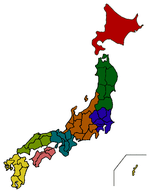Sakura Castle
Sakura Castle (佐倉城, Sakura-jō) was a 17th-century castle, now in ruins, in Sakura, Chiba Prefecture. It was designated one of Japan's Top 100 Castles by the Japanese Castle Foundation.[1]
History
Sakura Castle fall to Honda Tadakatsu and Sakai Ietsugu of the Tokugawa army during the Siege of Odawara (1590). Chiba Shigetane, daimyō of the Chiba clan, surrendered the castle to the besieging forces on the condition that his clan would not be abolished.
Under the orders of his Lord, Tokugawa Ieyasu, Doi Toshikatsu started construction of this castle in 1610. It was completed in 1617. It was based on the foundations and unfinished work of the Chiba clan, who had started building Kashima Castle on the same site, in the earlier Sengoku period.[2]
During the Edo era, it was ruled by powerful lords, all loyal to the Tokugawa rule. Sakura Castle was considered a location of strategic importance, in particular as it protected the eastern flank of Edo.[2] At its peak it was a large complex; however, it was noted for having no stone walls. The defensive lines were reinforced by deep, dry moats, and earthen embankments (ramparts) demarcated the baileys. The main keep was actually a yagura relocated from Edo Castle.[2]
The park was used for army barracks during World War II.
Current site
There is little left of the original castle, except for the moats, earthen walls, and some stone stairs. The National Museum of Japanese History stands on the site of the castle.[2]
References
- "日本100名城" (in Japanese). Japan Castle Foundation. Retrieved 29 May 2016.
- "Sakura Castle" jcastle.info http://www.jcastle.info/castle/profile/106-Sakura-Castle
Further reading
- Benesch, Oleg and Ran Zwigenberg (2019). Japan's Castles: Citadels of Modernity in War and Peace. Cambridge: Cambridge University Press. p. 374. ISBN 9781108481946.
External links

- http://japan-chiba-guide.com/narita-area/en/attractions/sakura-castle-park.html
